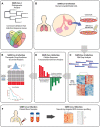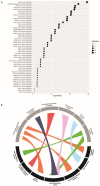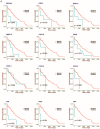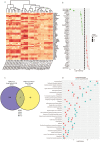Gene expression profiling of SARS-CoV-2 infections reveal distinct primary lung cell and systemic immune infection responses that identify pathways relevant in COVID-19 disease
- PMID: 33333559
- PMCID: PMC7799202
- DOI: 10.1093/bib/bbaa376
Gene expression profiling of SARS-CoV-2 infections reveal distinct primary lung cell and systemic immune infection responses that identify pathways relevant in COVID-19 disease
Abstract
To identify key gene expression pathways altered with infection of the novel coronavirus SARS-CoV-2, we performed the largest comparative genomic and transcriptomic analysis to date. We compared the novel pandemic coronavirus SARS-CoV-2 with SARS-CoV and MERS-CoV, as well as influenza A strains H1N1, H3N2 and H5N1. Phylogenetic analysis confirms that SARS-CoV-2 is closely related to SARS-CoV at the level of the viral genome. RNAseq analyses demonstrate that human lung epithelial cell responses to SARS-CoV-2 infection are distinct. Extensive Gene Expression Omnibus literature screening and drug predictive analyses show that SARS-CoV-2 infection response pathways are closely related to those of SARS-CoV and respiratory syncytial virus infections. We validated SARS-CoV-2 infection response genes as disease-associated using Kaplan-Meier survival estimates in lung disease patient data. We also analysed COVID-19 patient peripheral blood samples, which identified signalling pathway concordance between the primary lung cell and blood cell infection responses.
Keywords: COVID-19; MERS-CoV; RNAseq; SARS-CoV; SARS-CoV-2; coronaviruses; transcriptomics.
© The Author(s) 2020. Published by Oxford University Press. All rights reserved. For Permissions, please email: journals.permissions@oup.com.
Figures







Similar articles
-
Transcriptomic analysis reveals novel mechanisms of SARS-CoV-2 infection in human lung cells.Immun Inflamm Dis. 2020 Dec;8(4):753-762. doi: 10.1002/iid3.366. Epub 2020 Oct 30. Immun Inflamm Dis. 2020. PMID: 33124193 Free PMC article.
-
SARS-CoV-2 Isolates Show Impaired Replication in Human Immune Cells but Differential Ability to Replicate and Induce Innate Immunity in Lung Epithelial Cells.Microbiol Spectr. 2021 Sep 3;9(1):e0077421. doi: 10.1128/Spectrum.00774-21. Epub 2021 Aug 11. Microbiol Spectr. 2021. PMID: 34378952 Free PMC article.
-
The transcriptomic profiling of SARS-CoV-2 compared to SARS, MERS, EBOV, and H1N1.PLoS One. 2020 Dec 10;15(12):e0243270. doi: 10.1371/journal.pone.0243270. eCollection 2020. PLoS One. 2020. PMID: 33301474 Free PMC article.
-
Gene Expression Meta-Analysis Reveals Interferon-Induced Genes Associated With SARS Infection in Lungs.Front Immunol. 2021 Jul 23;12:694355. doi: 10.3389/fimmu.2021.694355. eCollection 2021. Front Immunol. 2021. PMID: 34367154 Free PMC article.
-
Innate Immune Signaling and Proteolytic Pathways in the Resolution or Exacerbation of SARS-CoV-2 in Covid-19: Key Therapeutic Targets?Front Immunol. 2020 May 28;11:1229. doi: 10.3389/fimmu.2020.01229. eCollection 2020. Front Immunol. 2020. PMID: 32574272 Free PMC article. Review.
Cited by
-
In-silico discovery of common molecular signatures for which SARS-CoV-2 infections and lung diseases stimulate each other, and drug repurposing.PLoS One. 2024 Jul 18;19(7):e0304425. doi: 10.1371/journal.pone.0304425. eCollection 2024. PLoS One. 2024. PMID: 39024368 Free PMC article.
-
The Initial COVID-19 Reliable Interactive DNA Methylation Markers and Biological Implications.Biology (Basel). 2024 Apr 7;13(4):245. doi: 10.3390/biology13040245. Biology (Basel). 2024. PMID: 38666857 Free PMC article.
-
COVID-19 patient transcriptomic and genomic profiling reveals comorbidity interactions with psychiatric disorders.Transl Psychiatry. 2021 Mar 15;11(1):160. doi: 10.1038/s41398-020-01151-3. Transl Psychiatry. 2021. PMID: 33723208 Free PMC article.
-
Transcriptome-based analysis of human peripheral blood reveals regulators of immune response in different viral infections.Front Immunol. 2023 Sep 19;14:1199482. doi: 10.3389/fimmu.2023.1199482. eCollection 2023. Front Immunol. 2023. PMID: 37795081 Free PMC article.
-
Applications of laboratory findings in the prevention, diagnosis, treatment, and monitoring of COVID-19.Signal Transduct Target Ther. 2021 Aug 25;6(1):316. doi: 10.1038/s41392-021-00731-z. Signal Transduct Target Ther. 2021. PMID: 34433805 Free PMC article. Review.
References
-
- Center JHCR. John Hopkins Coronavirus Resource Center.
-
- Heller N. Primary human airway epithelial cell transcriptome response to a wild type Mers-CoV (icMERS-CoV EMC2012). Gene Expression Omnibus, 2017.
MeSH terms
LinkOut - more resources
Full Text Sources
Medical
Miscellaneous

